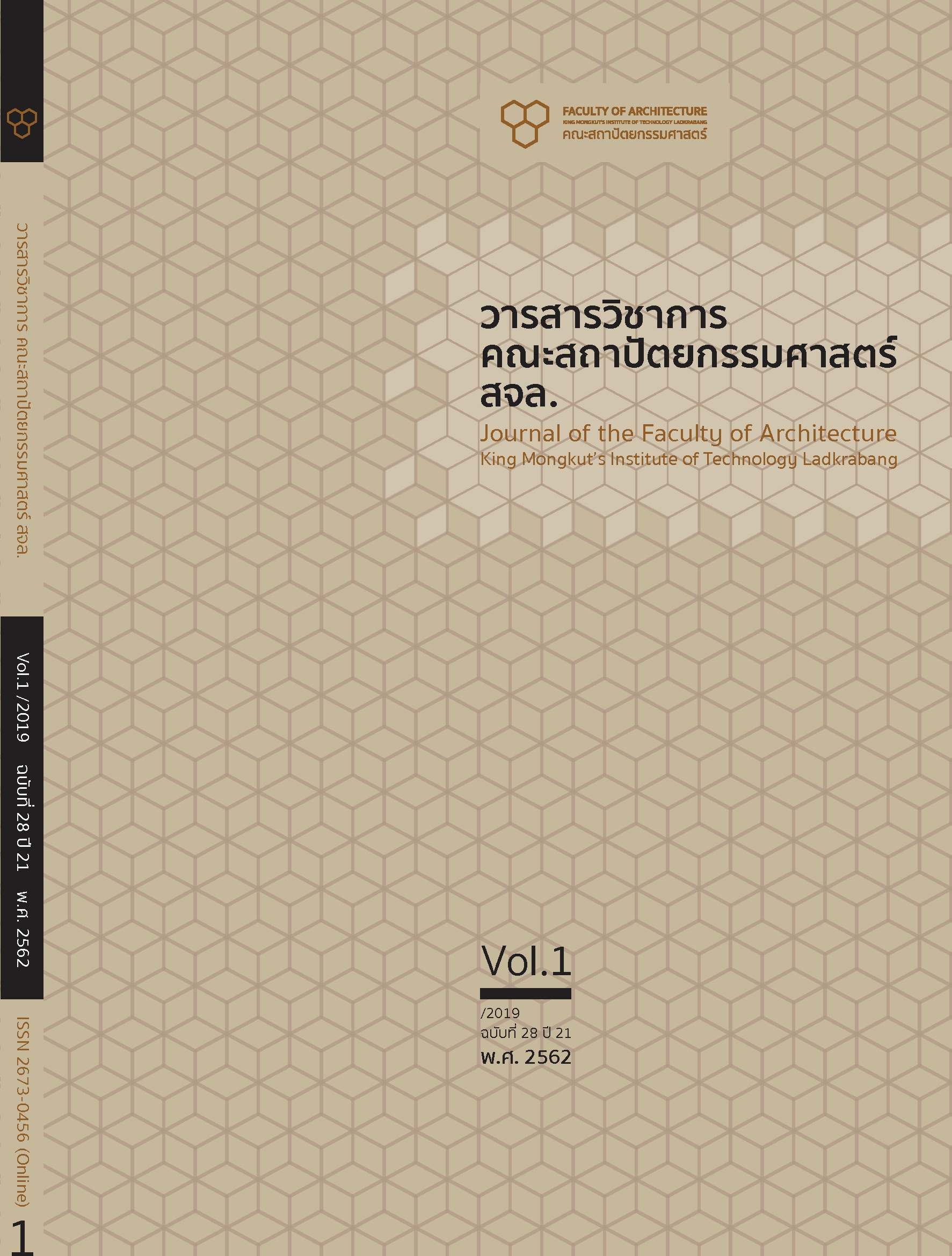The Process of Searching for Potential by Participation in the Development for Tourism in Palian, Trang Province
Main Article Content
Abstract
บทคัดย่อ
บทความวิจัยนี้เป็นการวิจัยเชิงปฏิบัติการด้วยกระบวนการมีส่วนร่วม ภายใต้โครงการวิจัยเพื่อพัฒนาเชิงพื้นที่ (ABC) บริเวณลุ่มน้ำปะเหลียน จังหวัดตรัง มีวัตถุประสงค์เพื่อค้นหาศักยภาพการพัฒนาเป็นแหล่งท่องเที่ยวชุมชนภายใต้ความสัมพันธ์ระหว่างลักษณะทางกายภาพของพื้นที่ รูปแบบสถาปัตยกรรม กิจกรรมและวิถีชีวิตชุมชนลุ่มน้ำปะเหลียน โดยผ่านกระบวนการมีส่วนร่วมของชุมชนด้วยการสำรวจพื้นที่ (1) ตำบลวังวน อำเภอกันตัง (2) ตำบลบ้านนา อำเภอปะเหลียน (3) ตำบลทุ่งค่าย อำเภอย่านตาขาว เพื่อศึกษาองค์ประกอบทางกายภาพและวิเคราะห์ประเมินศักยภาพของพื้นที่ร่วมกับการสัมภาษณ์และคืนข้อมูลสู่ชุมชนด้วยการจัดประชุมเชิงปฏิบัติการเพื่อพัฒนารูปแบบภูมิทัศน์ร่วมกับชุมชนอย่างต่อเนื่อง โดยมีผู้เข้าร่วมเป็นผู้นำกลุ่มชุมชน สมาชิกกลุ่มผู้ประกอบการท่องเที่ยวชุมชน และสมาชิกกลุ่มอนุรักษ์หอยปะ หน่วยงานท้องถิ่นที่รับผิดชอบพื้นที่ลุ่มน้ำปะเหลียน จำนวน 30 คน ผลการศึกษาพบว่าพื้นที่บ้านหินคอกควาย ตำบลบ้านนา อำเภอปะเหลียน เป็นพื้นที่ที่มีจุดเด่นของแหล่งท่องเที่ยวและมีศักยภาพเหมาะที่จะพัฒนาเป็นศูนย์กลางในการเชื่อมโยงไปสู่แหล่งท่องเที่ยวบริเวณใกล้เคียงทั้งทางบกและทางน้ำ ประกอบด้วยแนวคิด การวางผังเพื่อเชื่อมโยงการเข้าถึงพื้นที่ท่องเที่ยวเส้นทางเดิมชมวิถีชีวิตในชุมชนบ้านหินคอกควาย เส้นทางเดินชมธรรมชาติริมน้ำ และจุดแวะพักเพื่อชมวิว 1 จุด จุดชมอู่ต่อเรือปีด 1 จุด โดยมีแนวคิดหลักในการออกแบบที่คำนึงถึงความเหมาะสมและกลมกลืนกับบริบทสภาพแวดล้อมทั้งในส่วนของการใช้วัสดุ รูปแบบ และสี แนวทางการพัฒนาพื้นที่เพื่อการออกแบบภูมิทัศน์และรูปแบบสถาปัตยกรรมเพื่อการท่องเที่ยวด้วยกระบวนการมีส่วนร่วมที่ผ่านการแลกเปลี่ยนเรียนรู้ระหว่างชุมชน ทีมวิจัย หน่วยงานที่เกี่ยวข้องช่วยให้ชุมชนสามารถวิเคราะห์และแก้ปัญหาเพื่อพัฒนาศักยภาพของพื้นที่ให้เป็นแหล่งท่องเที่ยวอย่างยั่งยืน และเป็นต้นแบบนำไปประยุกต์ใช้เพื่อดำเนินการให้เกิดผลลัพธ์อย่างเป็นรูปธรรมได้กับพื้นที่ท่องเที่ยวอื่นภายใต้ความเหมาะสมกับบริบทของพื้นที่
คำสำคัญ: ภูมิทัศน์ ลุ่มน้ำปะเหลียน การมีส่วนร่วม การพัฒนาการท่องเที่ยว การค้นหาศักยภาพ
Abstract
This research is the action research under the project of Area-based Collaborative Research (ABC) inPalian Basin, Trang Province, and the objective of this research was to seek for potential to develop this area becoming a tourism destination in relation to the relationships among physical features of this area, architectural styles, activities, and the ways of life in communities in Palian Basin. The research process mainly was proceeded by community participation with on-site surveying on studied areas, including (1) Wang Won Khao District. The surveys and interviews were done in order to investigate physical components and analyze potential for being tourist-attraction point. Importantly, all data retrieved from the interviews were brought back to the communities’ members during workshop meetings for the development of landscape design. There were 30 communities’ leaders, from community-based tourism entrepreneur groups, Hoi Pa Conservation groups, and Palian Basin local offices. The research results revealed that the area of Ban Hin Khok Khwai in Ban Na Subdistrict, Palian District has a potential to be the tourist center linking neighborhoods’ tourist attraction points, both on-land and in-water. Therefore, the community planning to access the tourism route by walking to see way of life in Ban Hin Khok Khwai community and the natural route along the basin together with one stop point for sightseeing and one point for speed boat dockyard was conducted. The main design concept is considering an appropriateness and a harmony between the designs and contexts in terms of the use of materials, patterns and colors. Moreover, there was a way to develop the area for landscape design and architectural styles for tourism through the process of community participation to help the community so that they can analyze and solve problems in order to enhance potential of the area to be a sustainable tourism destination and a model applied to other tourism area under the suitability of the area context.
Keywords: Landscape, Palian Basin, Participation, Tourism Development, Searching for Potential
Article Details
This work is licensed under a Creative Commons Attribution-NonCommercial-ShareAlike 4.0 International License.
Copyright Transfer Statement
The copyright of this article is transferred to Journal of The Faculty of Architecture King Mongkut's Institute of Technology Ladkrabang with effect if and when the article is accepted for publication. The copyright transfer covers the exclusive right to reproduce and distribute the article, including reprints, translations, photographic reproductions, electronic form (offline, online) or any other reproductions of similar nature.
The author warrants that this contribution is original and that he/she has full power to make this grant. The author signs for and accepts responsibility for releasing this material on behalf of any and all co-authors.
References
กระทรวงการท่องเที่ยวและกีฬา. (2558). ยุทธศาสตร์การท่องเที่ยวไทยปี พศ. 2558-2560. เข้าถึงได้จาก: https://www.mots.go.th/ewt_dl_link.php?nid=7114.
การท่องเที่ยวแห่งประเทศไทย. (2561). Amazing Thailand Go Local. เข้าถึงได้จาก: https://golocal.tourismthailand.org/#whygolocal.
กุสุมา บุญกาญจน์ และ ชูวิทย์ สุจจฉายา. (2558). การจัดทำแนวทางอนุรักษ์และฟื้นฟูชุมชนดั้งเดิมด้วยกระบวนการมีส่วนร่วม กรณีศึกษาชุมชนแม่น้ำจันทบูร. เข้าถึงได้จาก: https://architservice.kku.ac.th/wp-content/ uploads/2016/02/04-Kusuma.pdf.
จตุรงค์ คงแก้ว, เยาวนิจกิตติธรกุล, และก้องเกียรติ กิตติวัฒนาวงศ์. (2560). กระบวนการพัฒนาพื้นที่การจัดการทรัพยากรทางทะเลและชายฝั่งโดยการมีส่วนร่วมของชุมชน: กรณีศึกษาเขตอนุรักษ์หอยปะ ลุ่มน้ำปะเหลียน จังหวัดตรัง. วารสารหาดใหญ่วิชาการ, 15(2), 147-163.
ชนิธิกาญจน์ จีนใจตรง, วรากุล ตันทนะเทวินทร์ และวราพรรณ ผลโพธิ์ .(2561). การพัฒนาแหล่งท่องเที่ยวและปรับปรุงภูมิทัศน์ภูป่าเปาะ จังหวัดเลย. วารสารวิชาการคณะสถาปัตยกรรมศาสตร์ สจล. 25(1), 74-91.
ชนัญ วงษ์วิภาค. (2532). นิเวศวิทยาวัฒนธรรม. กรุงเทพฯ: ภาควิชามานุษย์วิทยา คณะโบราณคดี มหาวิทยาลัย ศิลปากร.
ณัฐวุฒิ อัศวโกวิทวงศ์ และสุขุมาภรณ์ จงภักดี. (2548). การฟื้นฟูพื้นที่ว่างสาธารณะในชุมชนที่อยู่อาศัยของรัฐ กรณีศึกษา: โครงการเมืองใหม่บางพลี วาระที่1 ของการเคหะแห่งชาติ. วารสารวิจัยและสาระสถาปัตยกรรม/ผังเมือง. 2005(3), 187-206.
ธารทิพย์ ขาวผ่องอำไพ และธีรศักดิ์ อุ่นอารมณ์เลิศ. (2553). ผลที่เกิดจากการท่องเที่ยวเชิงเกษตรที่มีต่อสุขภาวะทางสังคมของคนในชุมชนคลองมหาสวัสดิ์ อำเภอพุทธมณฑล จังหวัดนครปฐม. วารสารศิลปากรศึกษาศาสตร์วิจัย มหาวิทยาลัยศิลปากร. 1(2), 100-113.
ธเนศ ศรีวิชัยลาพันธ์. (2556). การพัฒนาเศรษฐกิจชุมชน. เข้าถึงได้จาก: https://fuangfah.econ.cmu.ac.th/teacher/ thanes/files/Perfect%20Book2017.pdf
บุญเลิศ จิตตั้งวัฒนา. (2539). มาช่วยกันส่งเสริมการท่องเที่ยวเชิงอนุรักษ์กันเถิด. จุลสารการท่องเที่ยว. 15(1), 53-56.
บุญเลิศ จิตตั้งวัฒนา. (2548). การพัฒนาการท่องเที่ยวแบบยั่งยืน. กรุงเทพฯ: เพรส แอนด์ ดีไซน์.
ปาริฉัตร สิงห์ศักดิ์ ตระกูล และ พัชรินทร์ เสริมการดี. (2556). การศึกษาศักยภาพและแนวทางการพัฒนาการท่องเที่ยวเชิงอนุรักษ์ของชุมชนบ้านทุ่งมะปรังอำเภอควนโดนและบ้านปาหนัน อำเภอควนกาหลง จังหวัดสตูล. วารสารสุทธิปริทัศน์. 27(83), 97-112.
ยศ สันตสมบัติ. (2540). มนุษย์กับวัฒนธรรม. กรุงเทพฯ : สำนักพิมพ์มหาวิทยาลัยธรรมศาสตร์.
ราณี อิสิชัยกุล และ รชพร จันทร์สว่าง. (2560). การพัฒนามาตรฐานแหล่งท่องเที่ยวเชิงนิเวศของประเทศไทย. วารสารดุสิตธานี. 11(ฉบับพิเศษ), 1-17.
วิวัฒน์ เตมียพันธ์. (2530). แนวทางการศึกษาสถาปัตยกรรมพื้นถิ่น. กรุงเทพฯ: เมฆาเพลส.
สมชัย เบญจชย. (2549). การท่องเที่ยวเชิงนิเวศ. เอกสารประกอบการบรรยาย. หลักสูตรการบริหารจัดการป่าชุมชน และการพัฒนาอาชีพด้านป่าไม้. เชียงใหม่: กลุ่มงานวิชาการ สำนักบริหารพื้นที่อนุรักษ์ที่ 16.
สำนักงานคณะกรรมการวัฒนธรรมแห่งชาติ. (2551). การจัดการภูมิทัศน์วัฒนธรรมชุมชน. กรุงเทพฯ: โรงพิมพ์ ชุมนุมสหกรณ์การเกษตรแห่งประเทศไทย.
สำนักงานคณะกรรมการพัฒนาการเศรษฐกิจและสังคมแห่งชาติ. (2550). ยุทธศาสตร์การพัฒนาพื้นที่เพื่อรองรับการขยายตัวของอุตสาหกรรมและบริการของประเทศในอนาคต. วารสารเศรษฐกิจและสังคม. 44(3), 30.
อรทัย ก๊กผล. (2552). คู่มือการมีส่วนร่วมของประชาชนสำหรับผู้บริหารท้องถิ่น. กรุงเทพฯ: สถาบันพระปกเกล้า.
Bello, F. G., Carr, N., and Lovelock, B. (2016). Community participation framework for protected area-based tourism planning. Tourism Planning and Development. 13(4), 469-485.
Google Earth Pro. (2562). ลุ่มน้ำปะเหลียน. 7°21'50.59"N 99°33'57.97"E, elevation 7M, Retrieved from: https://www.google.com/earth/index.html.
Google Earth Pro. (2562). ลุ่มน้ำปะเหลียน (น้ำตกน้ำเค็ม). 7°26'21.86"N 99°37'4.85"E, elevation 7M, Retrieved from: https://www.google.com/earth/index.html.
Google Earth Pro. (2562). ลุ่มน้ำปะเหลียน (วังวน). 7°21'48.79"N 99°34'13.86"E, elevation 7M, Retrieved from: https://www.google.com/earth/index.html.
Google Earth Pro. (2562). ลุ่มน้ำปะเหลียน (หินคอกควาย). 7°20'48.69"N 99°35'43.80"E, elevation 7M, Retrieved from: https://www.google.com/earth/index.html.
Kunjuraman, V., and Hussin, R. (2017). Challenges of community-based homestay Programme in Sabah, Malaysia: Hopeful or hopeless?. Tourism Management Perspectives. 21(January 2017), 1-9.
Rasoolimanesh, S. M., Jaafar, M., Ahmad, A. G., and Barghi, R. (2017). Community participationin World Heritage Site conservation and tourism development. Tourism Management. 58(2017), 142-153.
Sherry R. Arnstein. (1969). A Ladder of Citizen Participation. Journal of American Institute of Planners. 35(1969), 216–224.


